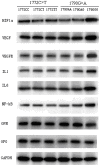HIF-1α polymorphism in the susceptibility of cervical spondylotic myelopathy and its outcome after anterior cervical corpectomy and fusion treatment
- PMID: 25401740
- PMCID: PMC4234507
- DOI: 10.1371/journal.pone.0110862
HIF-1α polymorphism in the susceptibility of cervical spondylotic myelopathy and its outcome after anterior cervical corpectomy and fusion treatment
Abstract
Background: To investigate the association between the single nucleotide polymorphism (SNP) of hypoxia-inducible factor1 α (HIF-1α) and the susceptibility to cervical spondylotic myelopathy (CSM) and its outcome after surgical treatment.
Method: A total of 230 CSM patients and 284 healthy controls were recruited. All patients received anterior cervical corpectomy and fusion (ACF) and were followed for 12 months. The genotypes for two HIF-1α variants (1772C>T and 1790G>A) were determined.
Results: In the present study, we found that the HIF-1α polymorphism at 1790G>A significantly affects the susceptibility to CSM and its clinical features, including severity and onset age. In addition, the 1790A>G polymorphism also determines the prognosis of CSM patients after ACF treatment. The GG genotype of 1790G>A polymorphism is associated with a higher risk to develop CSM, higher severity and earlier onset age. More importantly, we found that the 1790G>A polymorphism determines the clinical outcome in CSM patients who underwent ACF treatment.
Conclusion: Our findings suggest that the HIF-1α 1790G>A polymorphism is associated with the susceptibility to CSM and can be used as predictor for the clinical outcome in CSM patients receiving ACF treatment.
Conflict of interest statement
Figures


References
-
- Tamburrelli F, Di Lazzaro V, Pola E, Genitiempo M, Pilato F, et al. (2008) Cervical spondylotic myelopathy: proposal of a surveillance algorithm. Eur Rev Med Pharmacol Sci 12: 161–165. - PubMed
-
- Tracy JA, Bartleson JD (2010) Cervical spondylotic myelopathy. Neurologist 16: 176–187. - PubMed
-
- Oga M, Yuge I, Terada K, Shimizu A, Sugioka Y (1996) Tortuosity of the vertebral artery in patients with cervical spondylotic myelopathy. Risk factor for the vertebral artery injury during anterior cervical decompression. Spine (Phila Pa 1976) 21: 1085–1089. - PubMed
-
- Emery SE (2001) Cervical spondylotic myelopathy: diagnosis and treatment. J Am Acad Orthop Surg 9: 376–388. - PubMed
MeSH terms
Substances
LinkOut - more resources
Full Text Sources
Other Literature Sources
Medical

